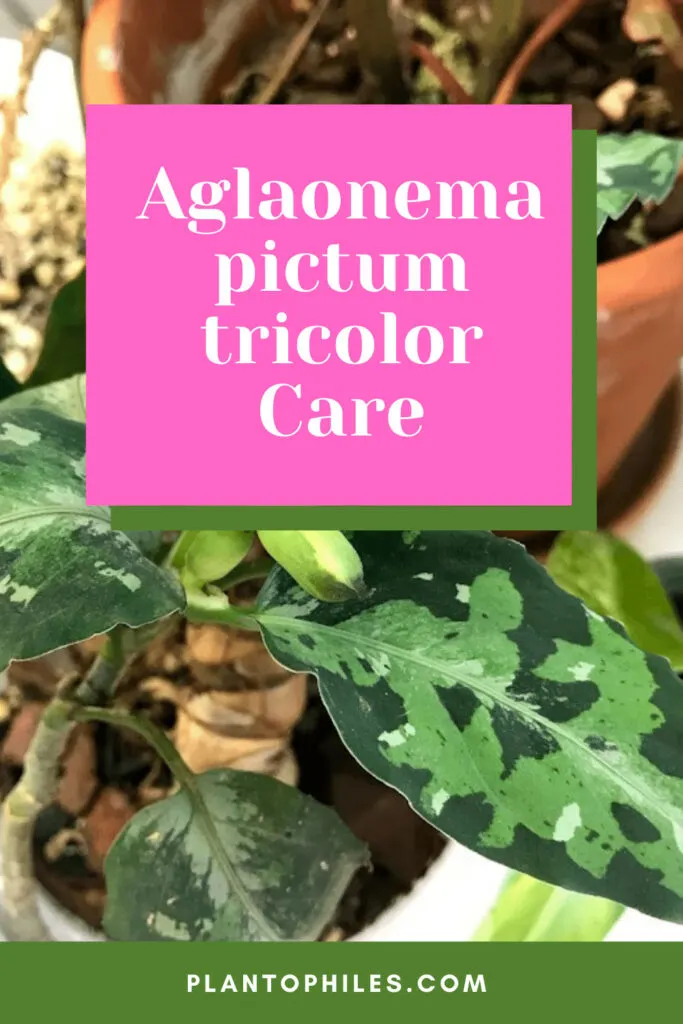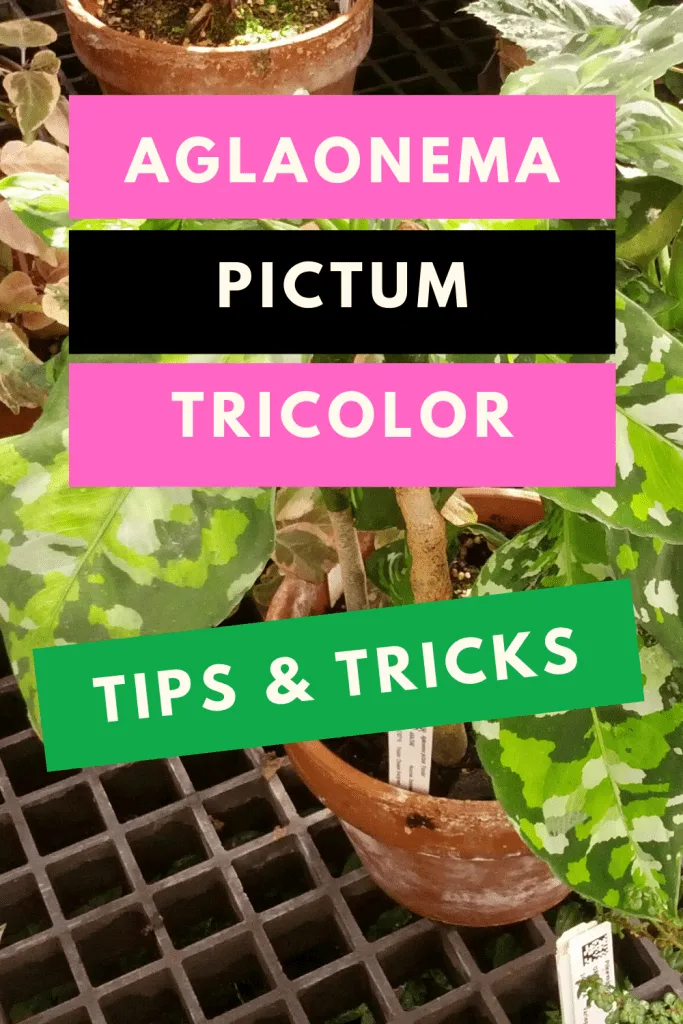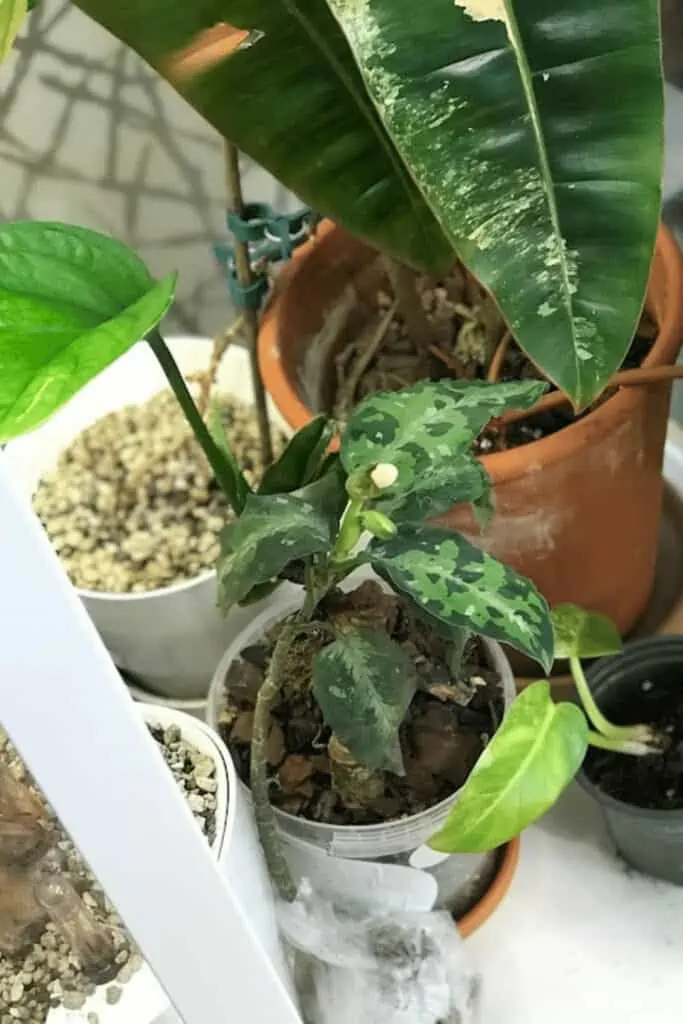(Photo By Seth Woodworth via StockPholio.net)
Aglaonema pictum tricolor, or Chinese Evergreen Tricolor, is a slow-growing sub-tropical shrub and the variegated form of the more common Aglaonema pictum species.
It is often referred to as the camouflage plant because of its pattern.
According to the Oxford Academic Website, the Aglaonema genus belongs to the Araceae family.
Aglaonema is a genus of 40 different species. The genus has hundreds of different cultivars and comes in many different colors.
Aglaonema pictum plants grow at 3280 – 6561 feet (1000 – 2000m) on the slopes of volcanos in Sumatra and Nias Island.
The species was described by Carl Sigismund Kunth in the year 1841.
Aglaonema pictum tricolor, as the name suggests, has three different colors on its leaves.
It has dark green, bright green, and white spotted leaves giving it this unmistakably cool army look.
Its leaves are oval to elliptic and longer than wide, and it has thick woody stems.
These plants are very rare and thought after. Not only are they hard to find, but they also tend to be quite pricey.
In most countries, an Aglaonema pictum tricolor will set you back around $200.
This article will cover all the relevant aspects of Aglaonema pictum tricolor care.
Aglaonema pictum tricolor Care
For Aglaonema pictum tricolor care provide a well-draining potting mix consisting of orchid bark, perlite, and peat and bright indirect sunlight. Keep the soil slightly moist when watering. The ideal temperature is 60°F to 85°F (16°C – 29°C) and humidity above 65%. Fertilize using a fertilizer at 1/2 strength bi-weekly in the growing season.

Table of Contents

Aglaonema Pictum Tricolor Care Guide
Soil
Well-draining rich soil of a mix of orchid bark, perlite, and peat is best for an Aglaonema pictum tricolor.
They do not like to be in compact soil.
A mix between perlite, orchid bark, and peat is a great mix for these plants.
Good drainage is essential as subtropical plants need a lot of humidity and frequent watering.
To avoid problems such as overwatering and root rot, your potting mix has to be airy and rainwater well.
A good indicator of well-draining soil is if the water drains quickly from the pot after you watered your plant.
Light
Aglaonema pictum tricolor needs bright indirect sunlight.
No direct sunlight, as this will burn the leaves of this plant.
Aglaonema pictum grows in low light conditions in the understory of very humid tropical forests.
However, this doesn’t mean you should only provide little light under houseplant conditions.
The sunlight in nature is much stronger than any grow light or light your plants receive through windows.
Since the Aglaonema Pictum Tricolor is variegated, it needs bright but indirect light to thrive and maintain its beautiful variegation.
Diffuse the light slightly to ensure it is not too direct or strong.
Watering
Keep the soil slightly moist for an Aglaonema pictum tricolor but do not overwater.
Keep the soil slightly moist but reduce watering in winter months.
Water frequently whenever the topsoil is about to dry out.
These plants do not take dry periods as well as overwatering very well.
I can tell from my experience that they are very fussy in this regard, and either over-or underwatering may lead to you losing this expensive jungle gem.
Temperature
Keep the temperature between 60°F to 85°F (16°C – 29°C) for an Aglaonema pictum tricolor.
This is a subtropical plant that needs to be kept warm.
It will not appreciate cold spells well. Avoid temperatures below 50°F (10°C) and make sure that winter temperatures stay in the range of 60°F to 64°F (16°C – 18°C)
Humidity
A humidity above 65% is advised for an Aglaonema pictum tricolor.
Keep the humidity levels up for this one.
Aglaonema pictum tricolor does best in Terrarium conditions where you can keep the humidity high.
This is a subtropical plant after all that grows in the jungles of Sumatra and Nias island.
Hight to very high humidity above 65% is advised.
I keep mine in a terrarium where the humidity stays above 90%, and my Aglaonema Pictum Tricolor thrives.
In case you can’t keep your Aglaonema in a terrarium, make sure to provide a pebble tray that is filled with water underneath.
If humidity is too low, these indoor plants tend to develop crisp leaves that will wilt quickly.

Fertilizer
Use a diluted fertilizer at half the recommended strength. Fertilize every two weeks in Spring and Summer.
Please do not feed the plants in the autumn and winter months when the plant is not in its main growing phase.
Propagation
Aglaonema pictum tricolor can be propagated by stem cuttings or division.
Further methods are root division and tissue culture.
Have a look below for a more in-depth step-by-step propagation tutorial.
Growth
Aglaonema pictum tricolor is 12-20 inches (30 -50cm) tall and has a woody stem of 0.1-0.8 inches (0.2-2.cm) wide.
Potting
Repot an Aglaonema pictum tricolor every 3-5 years in Spring or Summer to ensure it does not get root-bound.
Aglaonema Pictum Tricolor Propagation Step by Step
Let’s dive into how to propagate an Aglaonema pictum tricolor.
The most common way to propagate these beautiful Aglaonemas is to use stem cutting or division.
Propagate Aglaonema Pictum Tricolor from stem cuttings
Stem cutting is the way to go and the most common method to propagate Aglaonema pictum tricolor.
Make sure that the section you are cutting has several leaves and sections.
This will significantly increase the chance of successful propagation.
Most sources will suggest cutting with at least five leaves, but from my experience, even a section with no leaves can be propagated.
Let’s now have a look at the step-by.step propagation guide for Aglaonema Pictum tricolor:
- Identify a section of your plant that you want to propagate
- Make sure to have at least one node
- The top cuttings with the terminal bud usually have the most chances of success.
- Use a pruning shear (best choice), scissors, or a knife to cut the plant.
- Whatever tool you are using, make sure that you sanitize it before use
- I suggest holding it under a lighter for a couple of seconds and using rubbing alcohol afterward
- Make a clean cut on the stem of your Aglaonema Pictum tricolor
- Root the cutting in water, soil, coco coir, Sphagnum Moss or Perlite
- After 25-45 days, your cutting will start to develop roots and turn into a new plant
Other means to propagate your plant are root cuttings, propagation from seeds, or tissue culture propagation, also known as micropropagation.
For the last option, you will need sterile conditions and laboratory equipment.
I prefer the stem-cutting method and have done so with success in the past.
Aglaonema, however, is not an easy plant to propagate from my point of view, as cuttings rot quite easily and the roots that are forming are fragile.
Let’s now move over and look at the most common problems I hope you will never face with your plant.
Common Problems with Aglaonema Pictum Tricolor
Brown leaves
Brown leaves on an Aglaonema pictum tricolor are a typical sign of either underwatering or insufficient humidity.
These plants intake most of their water needs through their leaves as they grow in humid jungles in their natural habitat.
Crisp leaves and brown tips are usually a sign that the humidity levels you provide your plant are insufficient.
When you see brown spots on the leaves, ensure the soil is not too dry.
You should keep the soil of your Aglaonema slightly moist at all times and never let it dry out completely.
This is specifically important in the spring and summer months.
You can reduce your watering in winter but must adhere to a frequent watering schedule. Aglaonema pictum tricolor does not take underwatering well.
A different reason, as indicated, can be that the humidity levels are too low.
I recommend using a terrarium, as humidity should be kept at 65% plus for these tropical indoor plants.
If you keep them in your apartment or house, you will need to use different means to keep the humidity up in most conditions.
A good idea is a pebble tray filled with water. Misting once a day is also a good idea as Aglaonema pictum tricolor will absorb humidity through its leaves.
Yellow leaves
Yellow leaves are a typical sign of overwatering. Old leaves can also turn yellow and fall off.
However, I usually check if the root system is healthy whenever I spot a yellow leaf on my Aglaonema pictum tricolor.
Brown mushy roots clearly indicate that the soil has been too wet for too long and that your plant has developed root rot.
We talk about root rot in-depth in the following article.
Drooping leaves
Drooping leaves on an Aglaonema pictum tricolor indicates either too much sun or insufficient watering.
Closely monitor where your plant is when the leaves are starting to droop.
Does the Aglaonema get a lot of direct sunlight for multiple hours? If so, leaves will start to sag and might even curl.
A different reason for drooping leaves can be underwatering. Aglaonema pictum tricolor can store water in its stem but does not appreciate being underwatered.
A humid environment plays a further important role as Aglaonema Pictums intake much water through the air.
Let’s look at how you can ensure your Aglaonema is thriving.
Tips to keep Aglaonema Pictum Tricolor Problem-Free
Here is a summary of my top tips and tricks to keep your Aglaonema pictum tricolor growing healthy and vigorously:
- Providing high humidity of 65-90% is best. You can easily maintain this humidity level by providing an enclosure such as a terrarium for your Aglaonema.
- I cannot stress how vital the right soil mix is. Use light and airy potting mix. Read our best tips and tricks to mix optimal potting soil.
- Water regularity and never let the soil completely dry out
- Fertilize every two weeks during the primary growing season in spring and summer.
Moving on to the most frequently asked questions about Aglaonema pictum tricolor care.
Toxicity
Aglaonema pictum tricolor is poisonous to animals. They are also very toxic to humans.
Frequently Asked Questions
Where can I buy an Aglaonema pictum tricolor?
Aglaonema is a difficult plant to find. They are propagated in good numbers in Indonesia and Thailand and will find their way to the US and Europa through international trade. Your best bet is either a plant webshop for exotic plants online or sales through individuals’ Social Media platforms such as Facebook and Instagram.
Is the Aglaonema pictum tricolor color real?
The Aglaonema pictum tricolor is the variegated version of the Aglaonema pictum. Its color is not chemically induced or faked. It is a variegated variant of the Aglaonema pictum. The Aglaonema species is very variable in terms of colors, sizes, and looks.
Is the Aglaonema pictum tricolor difficult to care for?
Aglaonema pictum tricolor is a subtropical plant that grows in Sumatra and Nias island rainforests. It is accustomed to warm temperatures and high humidity. The better you can emulate these conditions, the bigger your success in caring for this indoor plant will be.
What humidity level does an Aglaonema pictum tricolor need?
As Aglaonema pictum tricolor grows in the subtropics, humidity above 65% is needed to keep your Aglaonema happy. I suggest using a Terrarium or plastic enclosure to keep humidity high.
How much does an Aglaonema pictum tricolor cost?
An Aglaonema pictum tricolor will set you back at least three digits. Depending on your location, it can cost anything between $150 and 450.
Conclusion
Aglaonema pictum tricolor is an army-patterned Aglaonema plant growing in humid jungles in Sumatra and Nias Island.
It is hard to get and, currently, rather an expensive plant to acquire. Its care is not recommended for beginners, and terrarium conditions are advised for it to thrive.
If you manage to keep humidity and the recommended temperatures in the suggested ranges, you will be able to enjoy the beauty of this plant for a long time.
Where did you get your Aglaonema pictum tricolor if you own one? Let us know in the comment section.

Daniel has been a plant enthusiast for over 20 years. He owns hundreds of houseplants and prepares for the chili growing seasons yearly with great anticipation. His favorite plants are plant species in the Araceae family, such as Monstera, Philodendron, and Anthurium. He also loves gardening and is growing hot peppers, tomatoes, and many more vegetables.


